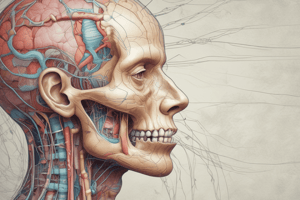Podcast
Questions and Answers
What is a characteristic feature of Wallenberg syndrome?
What is a characteristic feature of Wallenberg syndrome?
- Ipsilateral Horner's syndrome (correct)
- Contra lateral hemiplegia
- Bilateral hemiparesis
- Ipsilateral hemiplegia
In spinal cord lesions, what is lost at the level of the lesion?
In spinal cord lesions, what is lost at the level of the lesion?
- Ipsilateral sensation only
- Ipsilateral reflexes and sensation (correct)
- Contralateral sensation only
- Bilateral sensation
What is a common differential diagnosis for spinal cord lesions?
What is a common differential diagnosis for spinal cord lesions?
- Hypoglycemia
- Meningitis
- Encephalitis
- All of the above (correct)
What is a characteristic feature of Brown Sequard's Syndrome below the level of the lesion?
What is a characteristic feature of Brown Sequard's Syndrome below the level of the lesion?
What is a common investigation to diagnose stroke and discover mimics?
What is a common investigation to diagnose stroke and discover mimics?
What is a characteristic feature of Todd's paralysis?
What is a characteristic feature of Todd's paralysis?
What is a common differential diagnosis for brain lesions?
What is a common differential diagnosis for brain lesions?
What is a characteristic feature of Hysterical hemiplegia?
What is a characteristic feature of Hysterical hemiplegia?
What is a common investigation to exclude hematological disorders?
What is a common investigation to exclude hematological disorders?
What is a characteristic feature of Encephalitis?
What is a characteristic feature of Encephalitis?
Flashcards are hidden until you start studying
Study Notes
Hemiplegia
- Hemiplegia can be classified into different levels: cerebral, subcortical, capsular, brain stem, and spinal cord.
- Cerebral lesions:
- Hemiplegia is usually not complete, monoplegia is more common.
- Weakness is contralateral.
- Cloudiness of consciousness is common.
- Contra lateral cortical sensory loss in involvement of the parietal lobe.
- Convulsions may be focal or secondary generalized.
- Higher mental functions disorders (e.g. aphasia, agraphia, and agnosia) occur in lesions affecting specific lobes, centers, or sites.
Subcortical Lesions
- Weakness is more extensive compared to cortical lesions.
- Hemiplegia is usually complete.
- Hemi hypothesia on the paralyzed side is common.
- UMN facial and hypoglossal on the same side of paralysis are common.
Brain Stem Lesions
- Hemiplegia is termed crossed hemiplegia.
- Characterized by hemiplegia on the opposite side of the lesion with LMN cranial nerves affection on the same side of the lesion.
- Midbrain syndromes: e.g. Weber's syndrome (ipsilateral 3rd cranial nerve lesion, crossed hemiplegia).
- Pons syndromes: e.g. Millard Gubler syndrome (ipsilateral 6th, 7th cranial nerves lesion, crossed hemiplegia).
Clinical Features
- Onset: usually sudden in hemorrhage, may be subacute in thrombosis, acute or sudden in embolic.
- Course: may be regressive.
- Weakness: usually affects one half of the body, UL and LL in equal degree or one may be affected more than the other.
- Weakness affects group of muscles, affecting fine movements more, distal muscles are more affected.
- Progravity muscles are more affected than antigravity muscles.
Muscles Tone
- In acute lesions, there is a shock stage lasting for 2-6 weeks, during which there is a complete loss of tone of the paralyzed side.
- After this stage, tone gradually returns and spasticity appears.
- In gradual lesions, spasticity develops from the start and affects the antigravity muscles more than progravity muscles.
Deep Tendon Reflexes
- In the affected limbs, deep tendon reflexes are exaggerated, and pathological reflexes and clonus may be elicited.
- In the shock stage, deep reflexes are lost or diminished.
Superficial Reflexes
- The most important is the +ve Babinski sign.
- Abdominal and cremasteric reflexes are lost on the affected side.
Gait
- Gait is usually circumduction.
Medullary Syndromes
- Wallenberg syndrome: ipsilateral Horner's syndrome, ataxia, 9, 10, 11th cranial nerves, and decrease sensation over the face; contra lateral hemianathesia.
Spinal Cord Lesions (Brown Sequard's Syndrome)
- At the level of the lesion:
- Ipsilateral LMN weakness of muscles supplied by the affected segments.
- Loss of reflexes mediated by the interrupted segments.
- Loss of sensation (radicular) in the area supplied by the diseased segments.
- Below the level of the lesion:
- Ipsilateral hemiplegia.
- Ipsilateral deep sensory loss.
- Contra lateral superficial sensory loss.
Differential Diagnosis
- Hypoglycemia.
- Demylinating disease (e.g. MS).
- Brain tumors: history of headache, papilloedema, seizures, blurring of vision, progressive course, with gradual onset.
- Chronic subdural hematoma: history of head injury, weeks up to years before, more drowsiness, confusion & headache than the focal deficits.
- Encephalitis: acute or subacute onset of fever, cloudiness of consciousness, convulsions, signs of meningeal irritation, higher mental function disorders.
- Brain abscess: history of fever, headache with signs & symptoms of increased ICT, focal deficits, with source of infections (e.g. mastoditis, OM, congenital heart diseases).
- Todd's paralysis: history of epileptic seizures of focal onset.
- Hysterical hemiplegia: usually occurs in young age, with no +ve data on examination.
General Investigations
- Rapid one: to diagnose stroke and discover mimics.
- In ER: Blood sugar → to exclude hypoglycaemia.
- CBC & coagulation profiles → hematological disorders.
Studying That Suits You
Use AI to generate personalized quizzes and flashcards to suit your learning preferences.




